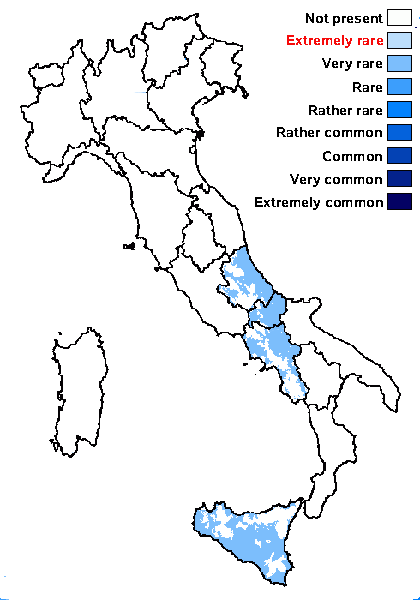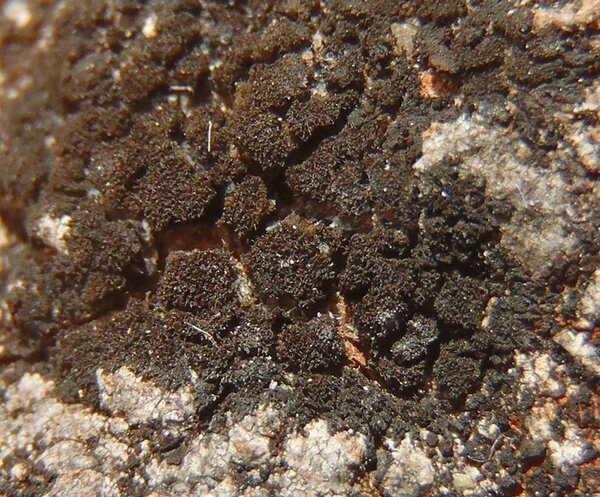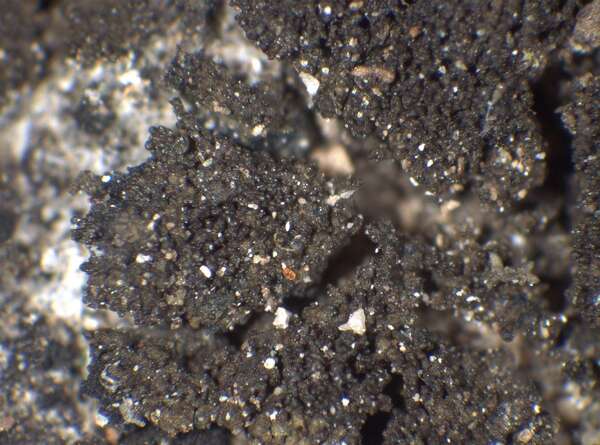Placynthium lismorense (Cromb.) Vain.
Ark. Bot., 8, 4: 98, 1909. Basionym: Pterygium lismorense Cromb. - Grevillea, 5: 108, 1877.
Synonyms:
Distribution: C - Abr (Nimis & Tretiach 1999), Mol (Nimis & Tretiach 1999, Caporale & al. 2008). S - Camp (Aprile & al. 2003b), Si (Nimis & al. 1994).
Description: Thallus crustose-placodioid, firmly attached, olivaceous brown to brown-black, epruinose, forming up to 2(-3) cm wide, irregular rosettes or convex pillows, usually without a visible prothallus. Central part of thallus covered in dense, granulose isidia-like outgrowths which are eventually eroded, leaving crescent-formed thalli; marginal lobes radiating, flattened, up to 1 mm long and c. 0.5 mm wide, 75-105 μm thick, finely divided into narrow, digitate segments. Apothecia rather frequent, lecideine, up to 1 mm across, with a flat to finally convex, black disc and a distinct, but often finally excluded proper margin. Epithecium blue-green; hymenium colourless, I+ blue; paraphyses distinctly septate, sparingly branched; hypothecium pale brown. Asci 8-spored, apically thickened, with an amyloid cap. Ascospores 1-septate, hyaline, slightly curved, broadly ellipsoid, 9-11(-13) x 5-6 μm. Photobiont cyanobacterial, Scytonema-like. Spot tests: all negative. Chemistry: without lichen substances.Note: on more or less calcareous rocks along seepage tracks at relatively low elevations. According to Jørgensen (2007) this species appears to be restricted to the western coasts of France, the British Isles and Scandinavia, but it was later confirmed from inland localities of Central Europe and the Iberian Peninsula (Burgaz 2010, Czeika & Czeika 2007).
Growth form: Crustose
Substrata: rocks
Photobiont: cyanobacteria, filamentous (e.g. Nostoc, Scytonema)
Reproductive strategy: mainly sexual
Commonnes-rarity: (info)
Alpine belt: absent
Subalpine belt: absent
Oromediterranean belt: absent
Montane belt: absent
Submediterranean belt: very rare
Padanian area: absent
Humid submediterranean belt: absent
Humid mediterranean belt: very rare
Dry mediterranean belt: very rare

Predictive model
Herbarium samples
Growth form: Crustose
Substrata: rocks
Photobiont: cyanobacteria, filamentous (e.g. Nostoc, Scytonema)
Reproductive strategy: mainly sexual
Commonnes-rarity: (info)
Alpine belt: absent
Subalpine belt: absent
Oromediterranean belt: absent
Montane belt: absent
Submediterranean belt: very rare
Padanian area: absent
Humid submediterranean belt: absent
Humid mediterranean belt: very rare
Dry mediterranean belt: very rare

Predictive model
| Herbarium samples |
 INDEX FUNGORUM
INDEX FUNGORUM
 GBIF
GBIF




